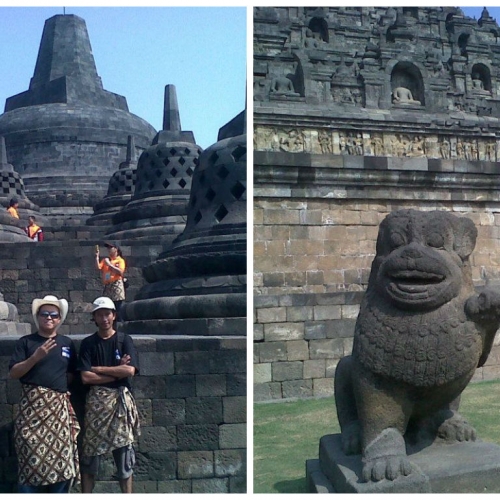(picture 1-6)
This picture describes a Buddhist temple in Magelang, Central Java, Indonesia. The temple is named Borobudur. This holy place for Buddha followers was built in the 9th century, or about the year 800 AD. This temple comprises of 6 levels of a square, 3 level in the form of circular and 1 main stupa. The total stupa is 10. At each level there are several stupas. (picture 1)
There are 10 levels of this temple describing 10 Buddhist Philosophy, Bodhisattva. Traditionally , the meaning of a bodhisattva is anyone who intend and achieve the perfection to be a Buddha in nirvana (heaven). Bodhisattva is one of the four sublime states a human can achieve in life besides Arhat, Buddha and Pratyekabuddha. (picture 3)
Stupa is a “heap”, something like a hemispherical structural containing Buddhist relics, typically the ashes of Buddhist holy men (monks). This site is utilized as a place of meditation. (picture 3,4 & 5)
The foreground of this picture (picture 2) is showing a landmark of UNESCO's honorary as the site which contributes the universal values to the world. It symbolizes the site as the world heritage list number 592.(picture 6). The place was restored with UNESCO's aid in the 1970s.

(picture 7-8)
Borobudur was built in three tiers; a pyramidal base with five concentric square terraces, the trunk of a cone with three circular platforms and at the top, a monumental stupa (the background of picture 7)
The pyramid concept describes Buddhist philosophy that all life came from rocks-stone become sand, then a plant and then into an insect then a wild animal and nets and the last to be human (picture 8). This process is known as reincarnation.
This enormous temple was constructed between 750 and 842 more than 300 years before Cambodia's Angkor Wat, and 400 years before the building of European Chatolic's cathedrals. Based on the literature, a colossal army of workers built this holy place in tropical heat to shift and carve the 60,000 m3 of stone (picture 8). Through this historical data, I can learn a lot how the ancestors have given outstanding heritage; the work ethics and work creativity to their next generation, more than 1000 years ago.
My friend and I are now obliged to wear Batik sarongs when I entered the temple. According to the event organizer the program is aimed at preserving and increasing the appreciation of the Borobudur Temple as cultural heritage. (picture 7)
My curiousity arouses me how the building can stand thousand years without nails and iron? How can this building keep the stability for more than a thousand year? The 42 meter-heighted building was built without using cement or adhesive. The stones are only connected with the pattern and just stacked it. I cannot imagine this temple was built supported by 55,000 cubic meters of stones (1).
(1)http://whc.unesco.org/en/list/592
Baca konten-konten menarik Kompasiana langsung dari smartphone kamu. Follow channel WhatsApp Kompasiana sekarang di sini: https://whatsapp.com/channel/0029VaYjYaL4Spk7WflFYJ2H








